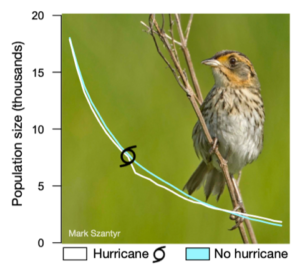Small Coastal Birds Can Weather Major Storms
People often use shorebirds as the quintessential example of birds affected by hurricanes, oil spills, and other major disturbances. But a research team led by a postdoctoral fellow at the University of Maryland’s National Socio-Environmental Synthesis Center (SESYNC) found that shorebird populations are actually quite resistant to these events.

Trajectory developed by the research team. Credit: Field et al 2019
The team, led by Christopher Field and colleagues from five other universities, found that shorebirds could absorb the impacts of a variety of storms. They used projections of population sizes based on birth and death rates and ran their simulations under multiple hurricane scenarios.
They looked at four different species, including the endangered Saltmarsh Sparrow, and found that all populations could absorb the storms’ impacts. In one scenario they ran, a storm caused mortality in a third of Saltmarsh Sparrows and Clapper Rails in one year, but the populations didn’t deviate from their trajectories over time.
The team measured resilience in two ways: absorbing storm impacts and recovery after disturbances. They found that the populations could recover in 20 years after large events, even if other threats affected them in that time period, like regular flooding.
The scientists noted that smaller, more regular, chronic stressors, like sea level rise, will continue to drive the shorebirds towards extinction, despite their resiliency to storm events. Scientists will need to consider major and chronic disturbances when modeling the future of shorebirds.
Read the full article on the SESYNC website.
